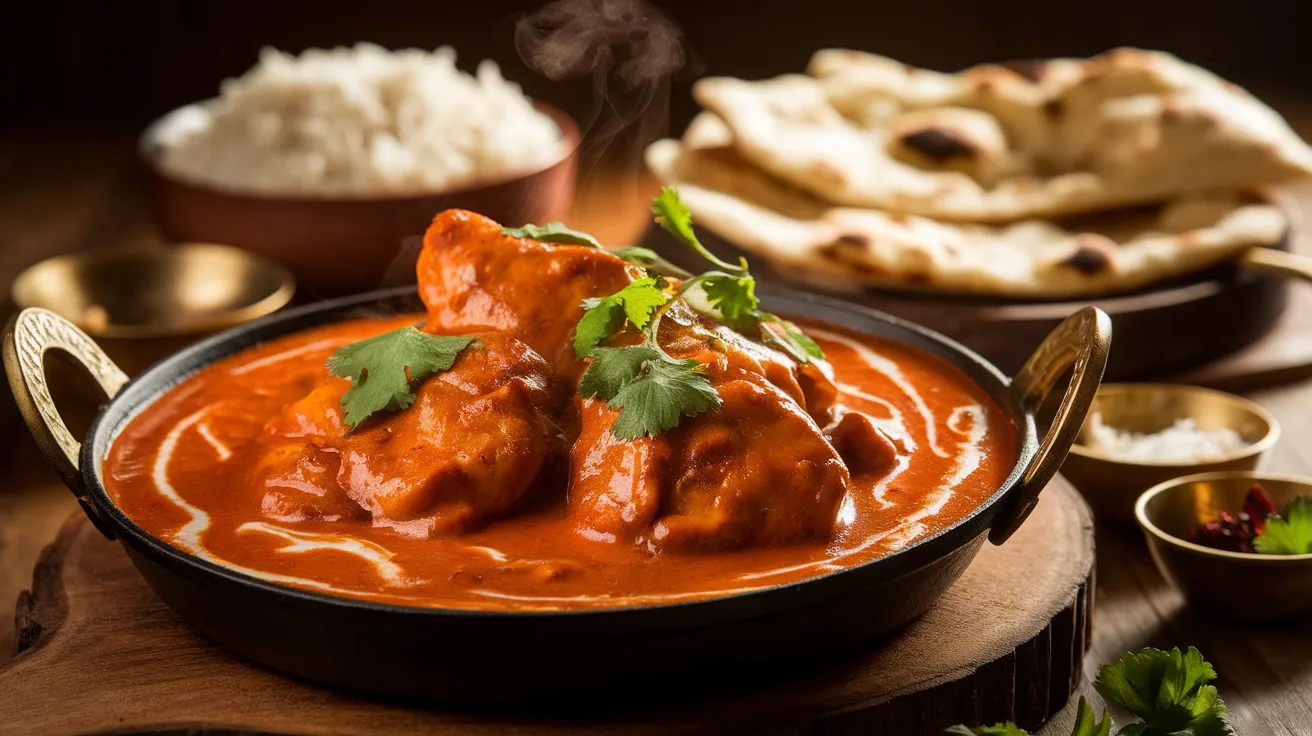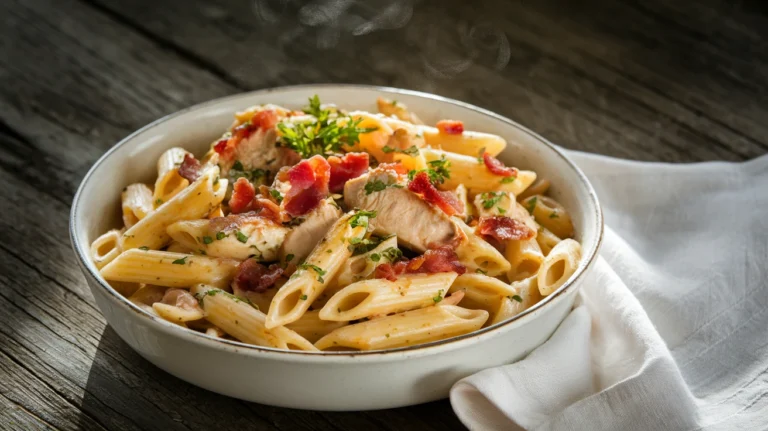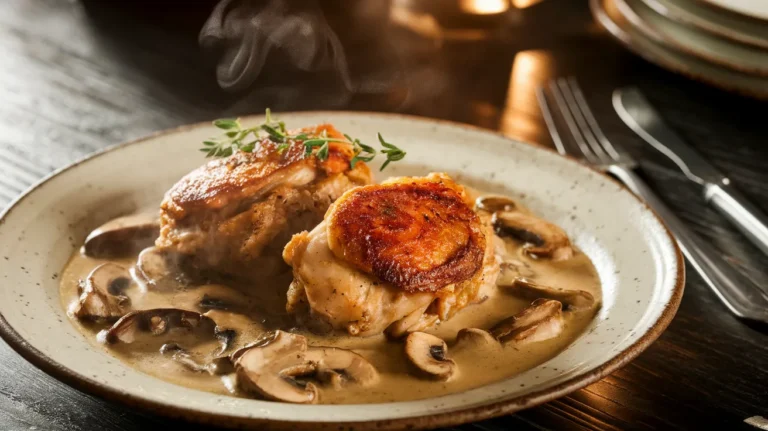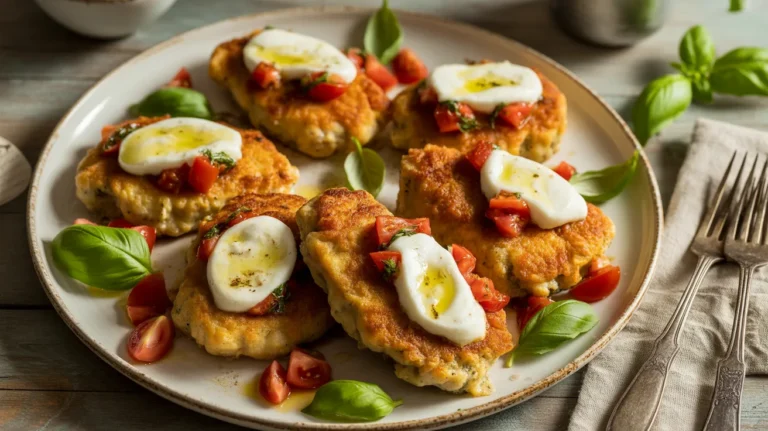Craving that creamy, aromatic Indian chicken tikka masala from your favorite restaurant? This authentic recipe brings those complex flavors right to your kitchen. With tender marinated chicken swimming in a velvety tomato-cream sauce, you’ll discover why this dish became Britain’s national favorite—and why it deserves a spot in your weekly dinner rotation.
SERVES: 4 | PREP: 30 MIN | COOK: 45 MIN | TOTAL: 75 MIN
Why This Indian Chicken Tikka Masala Works
This recipe breaks down the traditional two-step cooking process into foolproof phases. The yogurt marinade tenderizes the chicken while building flavor, and the sauce develops its signature depth through proper spice blooming. You’re getting restaurant-quality results without specialized equipment.
The key difference? Most home cooks skip the char on the chicken. That smoky edge transforms good tikka masala into unforgettable tikka masala.
Ingredients
For the Chicken Marinade
| Ingredient | Amount |
|---|---|
| Boneless, skinless chicken thighs | 1.5 lbs (cut into 1.5-inch pieces) |
| Plain yogurt (full-fat) | ¾ cup |
| Fresh lemon juice | 2 tablespoons |
| Garam masala | 2 teaspoons |
| Ground cumin | 1 teaspoon |
| Paprika | 1 teaspoon |
| Cayenne pepper | ½ teaspoon |
| Salt | 1 teaspoon |
| Garlic (minced) | 4 cloves |
| Fresh ginger (grated) | 1 tablespoon |
For the Tikka Masala Sauce
| Ingredient | Amount |
|---|---|
| Butter | 3 tablespoons |
| Vegetable oil | 1 tablespoon |
| Large onion (finely diced) | 1 |
| Garlic (minced) | 6 cloves |
| Fresh ginger (grated) | 2 tablespoons |
| Tomato paste | 3 tablespoons |
| Ground coriander | 2 teaspoons |
| Ground cumin | 2 teaspoons |
| Garam masala | 2 teaspoons |
| Paprika | 1 teaspoon |
| Turmeric | ½ teaspoon |
| Cayenne pepper | ¼ teaspoon |
| Crushed tomatoes (canned) | 28 oz can |
| Heavy cream | 1 cup |
| Sugar | 1 teaspoon |
| Salt | 1 teaspoon (adjust to taste) |
| Fresh cilantro (chopped) | ¼ cup |
Step-by-Step Instructions
Phase 1: Marinating the Chicken (15 minutes active, 2+ hours resting)
Step 1: Combine yogurt, lemon juice, garam masala, cumin, paprika, cayenne, salt, minced garlic, and grated ginger in a large bowl. Whisk until completely smooth—no spice clumps.
Why this matters: The yogurt’s acidity breaks down protein fibers, making the chicken incredibly tender. The longer it marinates, the deeper the flavor penetrates.
Step 2: Cut chicken thighs into uniform 1.5-inch pieces. Pat them completely dry with paper towels first.
Pro tip: Dry chicken = better marinade adhesion. Wet chicken dilutes your marinade and creates less flavor.
Step 3: Add chicken pieces to the marinade. Use your hands (wear gloves if preferred) to massage the marinade into every surface. Cover tightly with plastic wrap and refrigerate for minimum 2 hours, maximum 8 hours.
Warning: Don’t marinate longer than 8 hours—the yogurt can make the chicken mushy.
Phase 2: Cooking the Chicken (15 minutes)
Step 4: Remove chicken from refrigerator 20 minutes before cooking. Let it come to room temperature for even cooking.
Step 5: Preheat your oven’s broiler to high. Position the rack 6 inches from the heating element.
Step 6: Thread chicken pieces onto metal skewers (or arrange on a wire rack over a foil-lined baking sheet). Space them ¼ inch apart—crowding prevents charring.
Step 7: Broil for 12-15 minutes, rotating once halfway through. You’re watching for charred edges and internal temperature of 165°F.
Visual cue: The chicken should have dark brown, almost blackened spots. That’s the magic char that creates authentic tikka flavor.
Step 8: Remove from oven and let rest while you prepare the sauce. Don’t skip this rest—juices redistribute throughout the meat.
Phase 3: Building the Tikka Masala Sauce Base (10 minutes)
Step 9: Heat butter and oil in a large, deep skillet or Dutch oven over medium heat. The combination prevents butter from burning.
Step 10: Add diced onions with a pinch of salt. Cook for 8-10 minutes, stirring occasionally, until deeply golden and soft.
Temperature check: If onions brown in under 5 minutes, your heat’s too high. Lower it immediately.
Step 11: Add garlic and ginger to the onions. Cook for 90 seconds while stirring constantly.
Safety tip: Garlic burns quickly. If it starts turning brown instead of golden, it’ll taste bitter. Start over if this happens.
Step 12: Push onion mixture to the sides of the pan. Add tomato paste to the center and cook for 2 minutes without stirring—it should darken slightly.
Why this works: Cooking tomato paste removes raw acidity and concentrates the tomato flavor.
Phase 4: Spice Blooming (3 minutes)
Step 13: Add all ground spices (coriander, cumin, garam masala, paprika, turmeric, cayenne) directly to the tomato paste. Stir vigorously for 60-90 seconds.
Critical step: You’ll smell the spices transform—they’ll go from raw to fragrant. This “blooming” releases essential oils that create depth.
Step 14: Pour in crushed tomatoes immediately to stop the cooking process. Stir everything together, scraping up any browned bits from the bottom.
Phase 5: Simmering and Finishing (15 minutes)
Step 15: Bring sauce to a simmer, then reduce heat to low. Partially cover and cook for 10 minutes, stirring every 3 minutes to prevent sticking.
Step 16: Use an immersion blender to puree the sauce until completely smooth. (Alternatively, carefully transfer to a regular blender in batches—always vent the lid with a towel).
Texture goal: The sauce should look like thick, smooth tomato soup with no visible onion pieces.
Step 17: Return pan to medium-low heat. Stir in heavy cream, sugar, and salt. Taste and adjust seasoning—the sauce should be rich, slightly sweet, and balanced.
Step 18: Add the cooked chicken pieces (remove from skewers if used). Gently fold into sauce and simmer for 5 minutes to marry the flavors.
Final check: The chicken should be coated in sauce but not swimming. If too thick, add water one tablespoon at a time.
Step 19: Remove from heat and stir in fresh cilantro. Let rest for 5 minutes before serving—this allows flavors to settle.
Chef’s Notes
Chicken choice matters. Thighs stay juicier than breasts during the double-cooking process. If you must use breasts, check out this perfectly cooked chicken breast guide for timing adjustments, but expect slightly drier results with Indian chicken tikka masala.
Spice level control. This recipe sits at medium heat. Reduce cayenne to ⅛ teaspoon for mild, or bump to ¾ teaspoon for spicy. The cream tempers the heat significantly.
Cream substitute. Full-fat coconut milk works for dairy-free versions. The flavor shifts slightly tropical, but it’s delicious. Don’t use light coconut milk—it splits.
Garam masala quality. This spice blend loses potency fast. If yours is over 6 months old, use 3 teaspoons instead of 2. Fresh makes a tremendous difference in authentic Indian chicken tikka masala.
Nutrition Facts (Per Serving)
Calories: 520 | Protein: 38g | Carbohydrates: 18g | Fat: 34g | Fiber: 4g | Sugar: 10g | Sodium: 890mg
Delicious Variations
Paneer Tikka Masala: Swap chicken for 1.5 lbs cubed paneer cheese. Skip the marinade and char the paneer directly in a hot skillet with oil. Add to sauce in final step.
Tikka Masala Pizza: Use leftover chicken and sauce as pizza toppings with mozzarella and red onion. Finish with cilantro after baking. For pasta lovers, this works similarly to creamy chicken pasta dishes—rich, comforting, and endlessly adaptable.
Vegetarian Tikka Masala: Replace chicken with cauliflower florets, chickpeas, or a mix of bell peppers and mushrooms. Roast vegetables at 425°F for 25 minutes before adding to sauce.
Instant Pot Version: Marinate chicken as directed. Use Sauté function for steps 9-14. Add tomatoes and chicken, pressure cook 8 minutes, natural release. Stir in cream after cooking.
Storage & Reheating
Refrigerator: Store in airtight container for up to 4 days. The flavors actually improve on day two as spices continue melding.
Freezer: Freeze in portion-sized containers for up to 3 months. Leave ½ inch headspace for expansion. Thaw overnight in refrigerator.
Reheating: Stovetop is best—add 2-3 tablespoons water, cover, and warm over medium-low heat for 8-10 minutes, stirring occasionally. Microwave works but can make chicken rubbery (use 50% power in 90-second intervals).
Make-ahead strategy: Cook completely, cool rapidly, and refrigerate. This is actually ideal since flavors deepen overnight. Reheat portions as needed throughout the week.
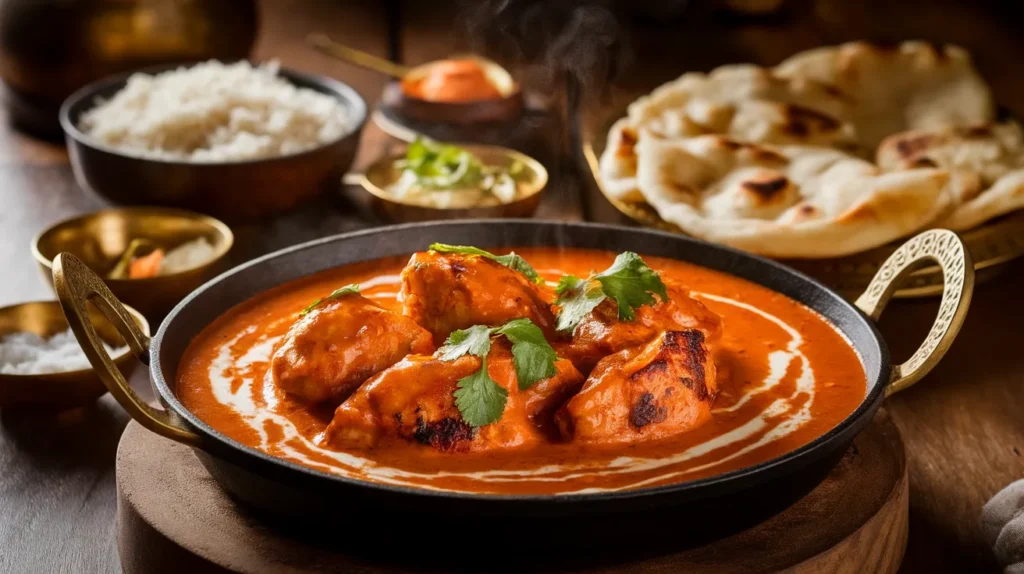
Troubleshooting Common Problems
Problem 1: Sauce is too thin and watery
This happens when tomatoes release excess liquid. Simmer uncovered for 5-10 additional minutes to evaporate moisture. If you’re in a hurry, mix 1 tablespoon cornstarch with 2 tablespoons water and stir into simmering sauce.
Problem 2: Chicken is dry and tough
You either overcooked during broiling or used lean chicken breasts. Check temperature with a meat thermometer—165°F is the target, not higher. Next time, reduce broiling time by 2 minutes and test early. Always use thighs for Indian chicken tikka masala.
Problem 3: Sauce tastes bitter
Burnt garlic or tomato paste is the culprit. Watch your heat carefully in steps 11-12. There’s no fix for bitter—start the sauce over. Cook over medium, not medium-high heat.
Problem 4: Not enough “restaurant flavor”
Two common issues: old spices or skipping the char. Replace spices older than 6 months and make sure chicken develops those dark, charred edges under the broiler. Restaurant versions also use more butter—add an extra tablespoon if you’re not concerned about calories.
Problem 5: Cream curdled in the sauce
The sauce was too hot when you added cream. Always reduce to medium-low heat first. If it happens, immediately remove from heat and vigorously whisk. It might come back together. Prevention is easier—temper the cream by mixing a few spoonfuls of hot sauce into it before adding to the pan.
Equipment Essentials
- Large mixing bowl for marinating
- Metal skewers or wire rack for broiling chicken
- Large deep skillet or Dutch oven (4-5 quart capacity)
- Immersion blender (or regular blender)
- Meat thermometer for foolproof chicken doneness
- Wooden spoon for stirring sauce
- Sharp knife and cutting board for prep
Shopping List
Produce Section
- 1 large onion
- 10 garlic cloves
- Fresh ginger root (3-inch piece)
- 2 lemons
- 1 bunch fresh cilantro
Meat Counter
- 1.5 lbs boneless, skinless chicken thighs
Dairy Case
- Plain full-fat yogurt (¾ cup)
- Heavy cream (1 cup)
- Butter (3 tablespoons)
Canned Goods Aisle
- 28 oz can crushed tomatoes
- Tomato paste (3 tablespoons)
Spice Aisle
- Garam masala
- Ground cumin
- Ground coriander
- Paprika
- Turmeric
- Cayenne pepper
Pantry
- Vegetable oil
- Salt
- Sugar
Success Secrets
1. Double the marinade time if possible. The 2-hour minimum works, but 4-6 hours creates restaurant-level tenderness. Plan ahead and marinate the night before for maximum flavor in your Indian chicken tikka masala.
2. Don’t skip the tomato paste caramelization step. Those 2 minutes in step 12 eliminate metallic tang and create a sweeter, richer base. Rush this and your sauce tastes one-dimensional.
3. Blend the sauce completely smooth. Rustic chunks might seem authentic, but silky-smooth sauce is the hallmark of great tikka masala. Blend for a full 30-45 seconds.
4. Taste and adjust at the end. Every brand of crushed tomatoes has different acidity. Start with recipe amounts, then adjust salt, sugar, and cream to balance your specific ingredients.
5. Serve with the right accompaniments. Basmati rice, warm naan bread, and cucumber raita complete the experience. The bread soaks up extra sauce—essential for getting every delicious drop of your Indian chicken tikka masala.
Serve hot with basmati rice and naan bread. This Indian chicken tikka masala tastes even better the next day, making it perfect for meal prep or entertaining.
